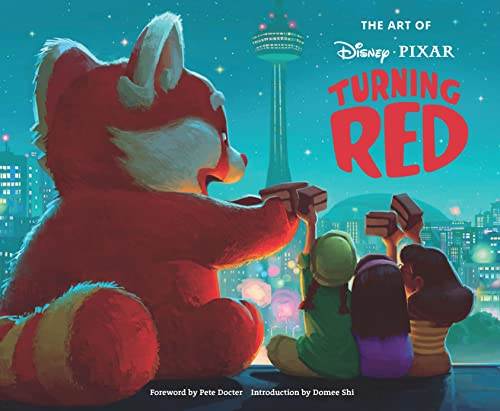Pixar’s Turning Red may be the studio’s third film to debut on Disney+ instead of in a movie theater, but that doesn’t mean it was made with any less than Pixar’s best and brightest. In The Art of Turning Red from Chronicle Books, this becomes abundantly clear, full of gorgeous artwork in a variety of mediums that showcase the film’s development from conception to final product. Whether you collect these Disney art books or because Turning Red is your new favorite film, there’s pure magic in these colorful pages.
The Art of Turning Red doesn’t just showcase the visual art of Pixar Animation Studios, but also their award-winning art of storytelling. Following a forward from Pixar’s chief creative officer Pete Docter (addressed directly to director Domee Shi’s mother under the assumption that nobody else will read it) and an introduction from Domee Shi, the artwork is presented mostly in story order. For this reason, I recommend that eager Pixar fans hold off on cracking their copy open until after they’ve seen the film on March 11th. It’s full of many twists and surprises and this is no way to have it spoiled for you.
Light on text, there are occasional paragraphs throughout the book from Pixar artists, who share anecdotes about the development the artistic style and story. A few things quickly stand out as you thumb through the pages. It’s easy to see the Studio Ghibli and anime influences that directly inspired Turning Red, with Easter Eggs in the artwork that I don’t think are in the film due to licensing reasons for characters like Sailor Moon and Pikachu. As you take note of the names attached to each piece of artwork or blurb, it also becomes clear just how diverse Pixar has grown to become, both in terms of gender and ethnicity. That diversity is also represented in a spread about the background characters created to populate Toronto.
Most Pixar films go through major story changes on their way to the screen, but with Turning Red, readers are left with the impression that Domee Shi’s original idea was so well laid out that it was continually “plussed,” but not torn down and rebuilt the way they usually are. As such, there’s not much insight into deleted sequences or characters, but there are a few pages devoted to funny gags that went unused, saved for the last few pages. The book also ends with a message of gratitude from producer Lindsey Collins, the only time the book mentions that the film was made not at Pixar’s campus in Emeryville, but from the homes of more than 300 artists assigned to the project.
The Art of Turning Red serves as a reminder that animated films are works of art. The amount of planning and attention to detail that is required in every frame are showcased in these pages. It allows fans of the film to linger in Meilin’s bubble gum Y2K version of Toronto and eagle-eyed readers may also pick up on some of Pixar’s signature Easter Eggs through the detailed artwork.


